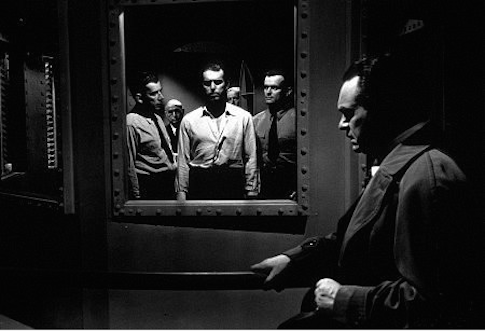The Skirball Cultural Center here on the west side of Los Angeles is a museum and exhibition space whose stated mission is "to explore the connections between four thousand years of Jewish heritage and the vitality of American democratic ideals." In Light & Noir: Exiles and Émigrés in Hollywood 1933-1950 it has amassed an impressive collection of photos, stock footage, archives, personal letters and original costumes that help to tell the uniquely American tale of the German immigrants—many of them Jewish—who made the Golden Age of American movie making possible.
In particular, the exhibit focuses on the immigrants’ contributions to Noir, one of the most disputed and beloved genres of the American film industry.
At the outset of the exhibit, the visitor is greeted by a wall-of-fame photo library of some of the key names and faces of period: Billy Wilder, Fritz Lang, Marlene Dietrich, and more. Skirball’s security guards patrol the various rooms of the exhibit on a mission that seems to be some combination of answering patrons’ questions and making sure that no one is sneaking a selfie in front of a mannequin of Lana Turner’s dress in The Postman Always Rings Twice.
There are encased personal letters from Hollywood power players like Carl Laemmle and Paul Kohner to their relatives or former creative collaborators in Eastern Europe, urging them to leave (circa 1935) before things got worse. Some listened, while others perished in Hitler’s genocide. There are re-created living room displays of where prominent Jewish writers, producers and directors would congregate for meals and fellowship in the homes of people like Salka Viertel in Santa Monica each week to try to keep some semblance of the cultural norms they had been forced to leave behind. There are mock screening rooms set up where clips from anti-Nazi "propaganda" films like Casablanca play on a loop, highlighting scenes in which the characters defiantly disobey German officers and sympathizers.
The flood of intellectual and creative talent from Europe during the ‘30s and ‘40s brought with them the unique perspective of people who had seen what totalitarianism was all about. American moviegoers responded in kind by gobbling their films up, even if they couldn’t quite explain what it was that spoke to them.
Classic Noir wasn’t simply pessimism on display. It was a world-weary, realistic portrayal of what human beings are capable of doing to each other. And while the world overseas seemed to spin out of control, the storytellers in Tinsel Town could at the very least see their heartless villains suffer for their choices—even if the "good guy" was hurt in the process. Directors like Billy Wilder and Fritz Lang captured this on film and homegrown stars like Bogart brought the heart and everyman quality to characters that domestic audiences might have found otherwise indigestible.
Also noteworthy as one strolls through the corridors of the Light & Noir exhibit is the very real role that Hollywood played in shaping the country’s views on topics such as the nation’s entrance into WWII and the threat of Nazism to the world. The aforementioned Casablanca is the most famous example of these pre-war efforts to rouse the American consciousness.
Materials on display in the exhibit reveal the fervor with which leading voices in the entertainment industry denounced Nazism as evil, dangerous and a direct threat to freedom-loving people everywhere. They did not mince words and they did not apologize for hating tyranny. One cannot help but wonder what happened to Hollywood—where did these voices go?
For film and history lovers in L.A. with some free time, the Light & Noir exhibit is well worth a visit.
RJ Moeller is a writer and entrepreneur based in Los Angeles.
